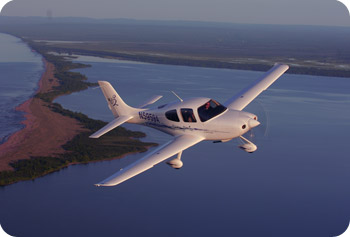
 |
|||||||||||||||||||||||||||||||||||||||||||||||||||||||||||||||||||||||||||||||||||||||||||||||||||||||||||||||||||||||||||||||||||||||||||||||||||||||||||||||||||||||||||||||||||||||||||||||||||||
|
|
|
CIRRUS Monthly Proficiency Program
|
||||||||||||||||||||||||||||||||||||||||||||||||||||||||||||||||||||||||||||||||||||||||||||||||||||||||||||||||||||||||||||||||||||||||||||||||||||||||||||||||||||||||||||||||||||||||||||||||||
|
It is the responsibility of you, the pilot-in-command, to determine when and how to use CAPS. To prepare for the event of pilot incapacitation, always review CAPS activation guidelines with your passengers before take-off. |
||
NTSB Accident Report
Begin your Ground Segment by clicking on the following
link to review the NTSB accident report:
Analyze the accident. Think about how the pilot or airplane contributed to the accident.
- What systems on the CIRRUS aircraft could have helped alter the outcome of this accident?
- Would declaring an emergency have resulted in more help from the controller?
- Are there any primary or secondary engine indications that the pilot could have noted prior to the crank shaft failing?
| Page 2 |
CIRRUS Monthly Proficiency Program
November – A Feather In Your CAPS
About CAPS
CAPS for the CIRRUS SRV, SR20 and SR22 is designed to lower the airplane
and its passengers to the ground after the pilot-in-command has decided the airplane
cannot be safely landed.
| NOTE: |
||
Activating CAPS should always be a last-resort safety measure. Specific examples of CAPS deployment scenarios include a midair collision, structural failure of the airframe or airframe components, loss of control, a forced landing in inhospitable terrain, pilot incapacitation, or any other situation where a safe outcome is in serious doubt.
|
| Page 3 |
CIRRUS Monthly Proficiency Program
November – A Feather In Your CAPS
CAPS Components
CAPS consists of several components. Click the link below for an interactive
view.

 |
NOTE: When the airplane is on the ground, a safety pin inserted into the handle prevents accidental activation. Always remove the safety pin before flight to allow immediate CAPS activation in the event of a life-threatening situation. |
| Page 4 |
CIRRUS Monthly Proficiency Program
November – A Feather In Your CAPS
![]()
CAPS Deployment
CAPS deployment occurs in several steps. Click the link below
for an interactive view.

| Page 5 |
CIRRUS Monthly Proficiency Program
November – A Feather In Your CAPS
![]()
CAPS Deployment (continued)
To deploy CAPS, follow these 3 steps:
1. Shut down the engine
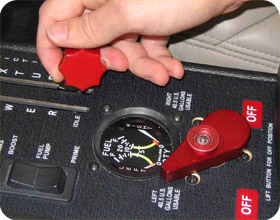
2. Remove the Cover
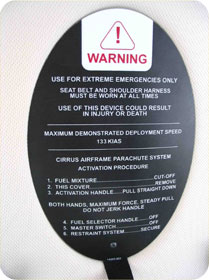
3. Place both hands on the handle and
pull, using a smooth, steady motion, as if performing a chin-up.
There will be some resistance, but it is not necessary to grab
and pull hard.

|
|
CAUTION: Pulling the CAPS handle commits to the full deployment sequence and airplane descent. Once deployed, the pilot cannot release or retract CAPS. |
||
| Page 6 |
CIRRUS Monthly Proficiency Program
November – A Feather In Your CAPS
![]()
CAPS Deployment (continued)
|
|
Remember: |
||
Additionally, the airplane may touch down pointing in a direction other than that of travel. Surfaces such as water, inclined ground or uneven rocks, trees or other obstacles may add to risk and the potential for injury or death.
Hitting the Ground—Safely
The force of the vertical impact will be approximately the same as dropping
the airplane from a height of 13 feet (4 meters) in a SR22 and 10 feet
(3 meters) in the SR20. Occupants should follow the CAPS Deployment procedures
described in the Pilot’s Operating Handbook (POH) Section 3 – Emergency
Procedures.
According to the NTSB Accident Database, the primary cause of airplane accident fatality is blunt force trauma. A typical power-off approach speed for single-engine general aviation airplanes similar to a CIRRUS is between 70 and 90 knots. The G-forces caused by impact at that speed can injure or kill the airplane occupants.
As an added measure of safety, the CIRRUS airframe absorbs a significant portion of the deceleration, further protecting you and your passengers. Additional safety features include composite main landing-gear struts, specially designed seats frames, impact-absorbing seat pans, four-point safety harnesses and, on newer models airbag seatbelts. By reducing forces on the human body during impact, CAPS increases the likelihood of survival.
| Page 7 |
CIRRUS Monthly Proficiency Program
November – A Feather In Your CAPS
![]()
CAPS Maintenance
There is no routine maintenance for you to perform on the CAPS. However, there
are inspection and service intervals for the parachute, rocket and snubber
line cutters. You will find these in the maintenance manual and in the
airframe logbook. As always, refer to your POH for specific deployment
guidelines, limitations and procedures.
|
|
CAUTION: Only licensed and qualified aircraft maintenance technicians are authorized to service CAPS. |
||
To Pull, or Not to Pull: That
is the Question!
Studies show that pilots who face situations caused by external
circumstances are much more willing to deploy an airframe
parachute than those who are faced with conditions caused
by poor decision-making and pilot error. In many situations,
the window for CAPS deployment is very short.
Regardless of the reason why the airplane can’t be safely landed, the pilot-in-command must be able to accept the loss of control and be willing to sacrifice the airplane in exchange for human life.
| Page 8 |
CIRRUS Monthly Proficiency Program
November – A Feather In Your CAPS
![]()
Avoid a False Sense
of Security
Although CAPS provides additional safety security, thinking of it as a “fallback” will
create a false sense of security that you really want to avoid. Do not alter
your pre- and in-flight decision-making process with CAPS in mind.
Do not lower your personal minimums or fly into situations you would otherwise avoid in a non-CAPS-equipped airplane. Approach all flight in mountainous terrain, over open water, and in marginal weather conditions with sound decision-making.
While CAPS is designed to save lives, good pilot decision-making skills and preflight planning should eliminate the need—except in the most unforeseen and hazardous situations. Use good pilot preparation and decision-making as the primary means of protecting yourself and the occupants of your airplane. Make good choices and do not use the parachute as an excuse to extend either your capabilities, or those of the airplane.
| Page 9 |
CIRRUS Monthly Proficiency Program
November – A Feather In Your CAPS
![]()
CAPS Deployment vs. Off-Field Landing
Airplanes without a parachute will impact the ground with a force
16 to 22 time greater than a CIRRUS having deployed CAPS. Although
the vertical velocity may be less than in another airplane,
ignoring the forward velocity is a fallacy.

| Page 10 |
CIRRUS Monthly Proficiency Program
November – A Feather In Your CAPS
![]()
Safety Begins on the Ground
Begin planning on the ground with a thorough safety briefing for both yourself
and your passengers. In the event that you become incapacitated, a passenger
or passengers may have to activate CAPS. They should know the basics of
its limitations and operation.
|
Passengers Under Stress Require KISS Keep emergency instructions simple. In their pre-flight briefing, some pilots use the “3 Red” approach, which covers the 3 key points of the After-Deployment Checklist. In your own words, consider saying to your passengers: "In the event we deploy CAPS, there are 3 things in this airplane you need to remember to do, and all three are red:"
|
||
| Page 11 |
CIRRUS Monthly Proficiency Program
November – A Feather In Your CAPS
![]()
After Deployment Checklist
If you do activate CAPS, follow the “After Deployment Checklist” below.
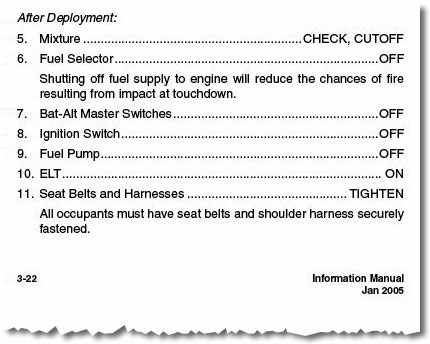 |
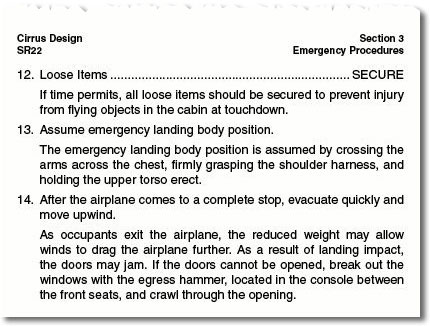 Source: CIRRUS POH, Section 3-21 - 22 |
| Page 12 |
CIRRUS Monthly Proficiency Program
November – A Feather In Your CAPS
![]()
Doors
Remember that the airplane’s doors are an integral part of the airframe
structure. Keep them closed to ensure airframe continuity. If they jam after
the parachute deploys, or upon landing, use the emergency egress hammer to
break the side windows.
Remember that the airplane may drift, or prevailing winds may drag it along the ground. So make sure the airplane has come to a complete stop before exiting.

Source:
CIRRUS POH, Section 10-8
| Page 13 |
CIRRUS Monthly Proficiency Program
November – A Feather In Your CAPS
![]()
The Ultimate Lifeline
The Cirrus Airframe Parachute System is the ultimate lifeline when you have
exhausted all other options to assure a safe landing in the event of a
life-threatening
emergency. It has proven its worth in the field.
To make best use of CAPS, you must understand the system, its deployment procedures and its limitations. During pre-flight planning, it is also good practice to brief situations that might demand a CAPS deployment to each pilot.
CAPS is there to help protect you and
your passengers when the pilot-in-command has decided the airplane
cannot be safely landed. However, good decision making, proper risk
management and adherence to personal
minimums should always be your primary line of defense against accidents
and incidents.
![]()
| Page 14 |
CIRRUS Monthly Proficiency Program
November – A Feather In Your CAPS
![]()
Objective:
The flight portion for the November
CIRRUS Monthly Pilot Proficiency program is designed to increase
your knowledge of CAPS and the situations preventing a safe
landing that may require the pilot-in-command to deploy the
system. Rapid evaluation of the risks associated with various
scenarios will help you quickly determine the best course
of action.
You should complete the following exercises only in good visual flight rules weather conditions and, if possible, with a Cirrus Standardized Instructor Program (CSIP) instructor.
|
To learn more about CSIP instructors available in your area, go to: www.cirrusdesign.com/csip |
||
Do not use view-limiting devices unless a qualified safety pilot is present. In all scenarios, maintain control of the airplane and observe good operating practices. At no point should you allow a simulation to develop into a real emergency.
|
|
IMPORTANT: It is recommended that the pilot flying during the scenario touch the CAPS handle cover and announce the CAPS deployment procedure without actually removing the cover. DO NOT remove cover or pull the handle from its cradle unless the pilot-in-command has decided that the airplane cannot be safely landed. |
||
Items to Simulate
in the Air
NOTE: At no time during the simulation situations below should
the airplane to put into an attitude or condition that would
require CAPS deployment.
Plan a cross-country with three legs of approximately 30 minutes each. Be prepared for diversions and simulated instrument conditions. Simulate the following situations:
- Loss of control surface continuity
- Engine loss over inhospitable terrain.
- Disorientation in Instrument Meteorological Conditions (IMC) and Visual Meteorological Conditions (VMC)
- Engine loss in LIFR
- Loss of control
- Mid-air collision or catastrophic bird strike
![]() For
a Printable PDF version of this information, CLICK HERE.
For
a Printable PDF version of this information, CLICK HERE.
![]()
| Page 15 |
CIRRUS Monthly Proficiency Program
November – A Feather In Your CAPS
![]()
You will successfully complete the November CIRRUS Monthly Pilot Proficiency program when you gain a thorough understanding of CAPS: what it is, how it works and, especially, the situations preventing the pilot-in-command from safely landing the airplane that require CAPS deployment.
Until next month, put a Feather in Your CAPS and fly safely!
Thanks for visiting CIRRUS Pilot’s World and taking the November Monthly Proficiency Program. We hope you enjoyed the experience and that it has helped to increase your awareness, skill and proficiency in safely flying your CIRRUS SRV, SR20 or SR22. Please take a moment to give us your feedback about this month’s course. Your suggestions will help us provide you with courses to improve your all-around flying safety and enjoyment Write to us at: pilotsworld@cirrusdesign.com. See you next month!
|
| Page 16 |

